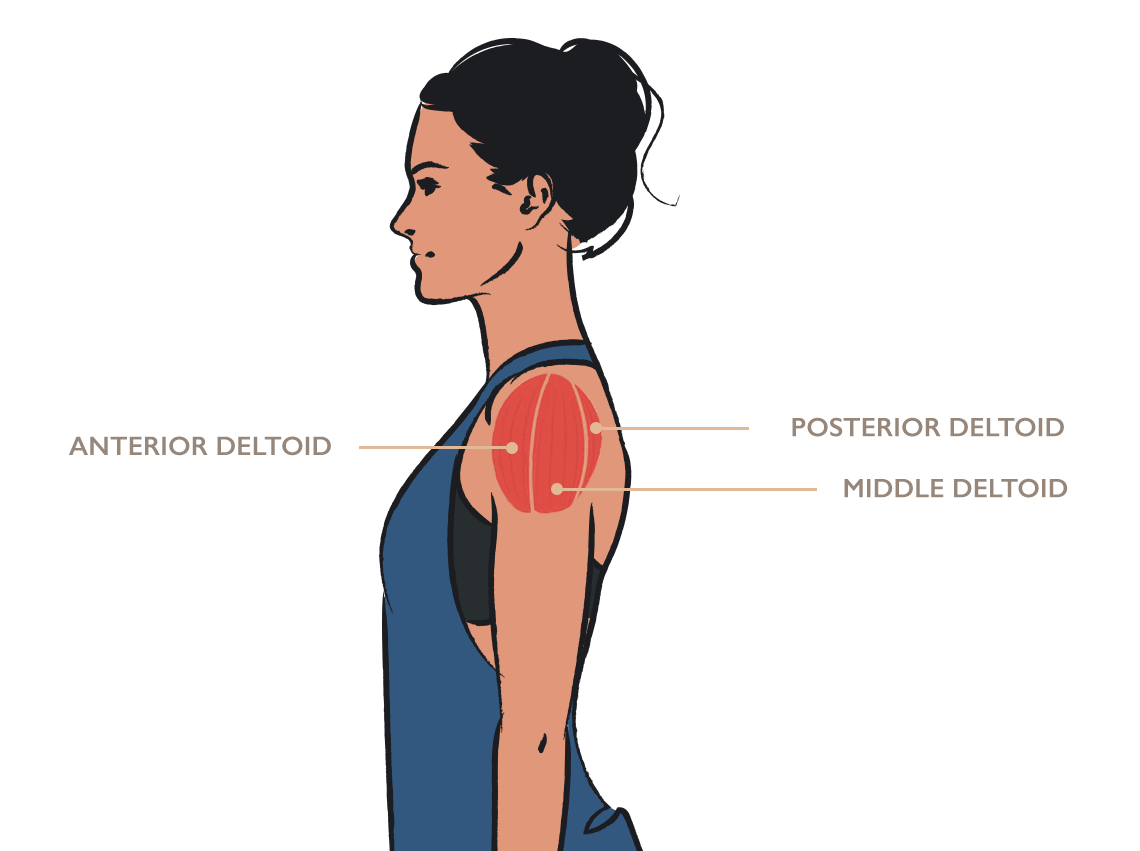Sculpting strong and shapely shoulders doesn’t just improve the upper body aesthetics, but also strengthens and stabilizes the least stable, most mobile joint in the body – the shoulder. The shoulder muscles play a key role in allowing you to move your arms freely and strongly.
<< Spotlight >>
Shoulder Anatomy
Here’s an easy guide to the shoulder muscles that you’ll want to target.
The deltoid muscle consists of three parts.
Anterior deltoid. This muscle is located on the front of the shoulder. It is also called the front delt and is the strongest part of the deltoid. The main function of the front delt is to raise the arm to the front, such as to reach for an object on a shelf, and to rotate the arm inward toward the midline of the body. It helps with any pushing movement, such as pushing something away from you or up over your head.
This muscle is targeted in many pushing chest exercises (e.g. push-ups), as these muscles work closely together, and doesn’t need to be targeted with shoulder-specific exercises.
Unless you have specific needs (e.g. rehab from a shoulder injury), it’s generally best to limit or avoid isolation exercises targeting the anterior deltoid. This is to reduce the risk of overtraining and muscular imbalance between the front and the back of the deltoid, which may lead to poor posture and injury.

Middle deltoid. Also called lateral deltoids or side delts, it is found on the outer side of the shoulder. This muscle is responsible for raising your arms up and out to the side, such as when you do jumping jacks. The lateral deltoid helps to make the shoulders look wider.
Posterior deltoid. The posterior deltoid, also known as the rear delt, is located on the back of the shoulders. It helps to extend the arm behind the body and also rotates the arm outward. Not many exercises target the rear delt and it’s at the back of the shoulder, so you can’t see it. In other words, it’s the forgotten muscle. To compound matters, it is also the weakest of the three deltoid heads.
Strengthening this muscle helps to pull your shoulders back, which is important in counteracting slouching shoulders. While this muscle does get worked a little with exercises that target the back, it should be targeted with specific exercises.
Main Types of Shoulder Exercises
A holistic workout should include different types of shoulder exercises. Shoulder exercises can be roughly dived into 3 categories.
Easy Rule
When working your deltoids with free weights (e.g. dumbbells), you’ll know which part is being targeted the most with this simple rule of thumb: Whichever part of the deltoid is facing the ceiling is being worked the hardest.
Shoulder Exercise Library
Shoulders & Co
Why Strengthen Your Shoulders
These are some of the benefits of shoulder exercises.
Improves functional strength and athletic performance. Strengthening your shoulders makes most arm movements easier, from reaching for something to carrying heavy groceries. It also improves athletic performance in activities that require strong shoulders, including swimming, rock climbing, yoga, and sports that involve hitting or throwing a ball, such as tennis or baseball. Furthermore, most upper-body exercise target your shoulder muscles to some extent, which means that stronger shoulders will help you perform exercises better and lift heavier weights.
Injury prevention: Weak shoulders are more likely to lead to pain and injury down the road, whether from playing sports or lifting a heavy suitcase. However, building stronger shoulders can reduce the risk of sustaining shoulder pain or injuries.
- Better posture. Shoulder exercises can help improve posture and reduce neck and shoulder pain associated with sitting hunched over for hours at your office desk, which can cause the shoulder to round forward. 1
Aesthetics. Strengthening the shoulders adds definition and shape to the upper body. Exercises targeting the middle deltoids can widen the shoulders and make the waist look smaller, to create a more tapered body shape.
Shoulder Exercise Tips
When targeting the shoulder muscles, ensure that you work the different parts of the shoulders.
- Don’t forget the rear deltoid. We are generally stronger at the front of the body and our everyday posture – sitting hunched over a desk – rarely engages the posterior deltoid. Furthermore, the front and middle shoulder is easier to train, and the front deltoid is often worked when doing chest exercises. However, training these parts of the shoulder, while neglecting the posterior deltoid can lead to an unbalanced look, worsen posture, and may increase the risk shoulder injury. Some experts recommend starting the shoulder workout with exercises that target the posterior deltoid, because it is tends to be weakest.
- Perhaps skip the front deltoid. Some trainers recommend that you completely avoid training the anterior deltoids directly with specific shoulder exercises. That’s because the front delt is trained enough as part of doing chest exercises like push-ups. Working it again with isolation exercises may lead to overtraining. Instead focus on the middle and posterior deltoid.
- Choose the right weight. Choose a weight that allows you to complete the exercise with good form. Shoulder exercises such as lateral raises don’t require a lot of weight to be effective. Going too heavy can recruit the wrong muscles like the trapezius and make the exercise less effective. It may also place extra stress on your back and other muscles, increasing the risk of injury.
- Do not completely extend your elbows. Avoid fully extending (straightening) your elbows when performing upper body exercises. Your elbows should have a slight bend, especially during pressing exercises and raises. Fully extending the elbows can also cause the trapezius muscle to take over. Keeping your arm slightly bent will make sure that only your shoulders are doing the work.
Just because the past taps you on the shoulder, doesn't mean you have to look back.

